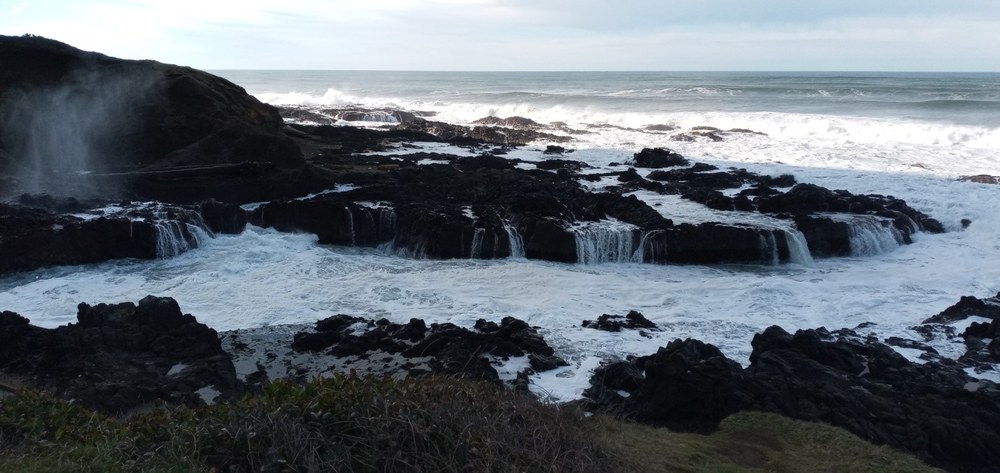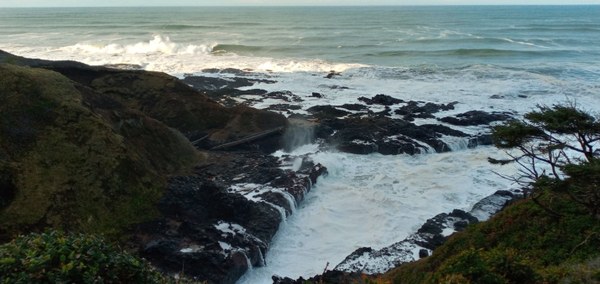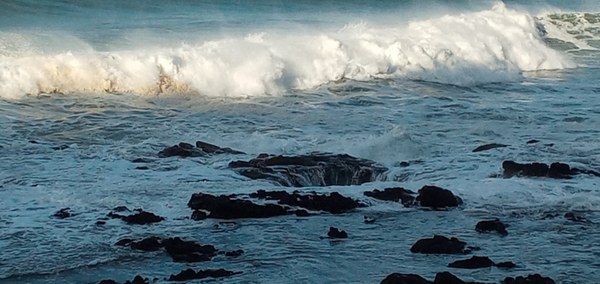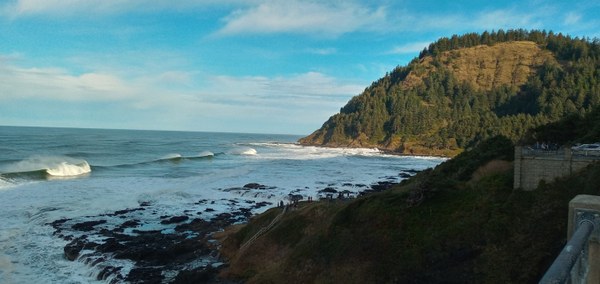
For our third installment of the Oregon Winter Adventure series, we take a look at Cape Perpetua and the geological marvels that it holds. Learn about this gorgeous spot along the Oregon Coast, and how to maximize your visit if you choose to head south for some seaside adventures.
Interested in parts one and two of this series? Take a look at our trip reports to Ecola State Park, Haystack Rock (Cannon Beach), and Hug Point and Yaquina Head Lighthouse and Seal Rock.
Cape Perpetua
Cape Perpetua holds many spectacular coastal wonders that make this area unique. It is exceptional, and I believe worth spending time exploring! Some key highlights include Spouting Horn and Thor’s Well. The area is the ancestral home of the Alsi (Alsea) Native peoples. Cape Perpetua, also known as “Halaqaik”, meaning uncovered place, is where the Alsi once had a coastal village. Here they hunted, fished, dug for clams, collected mussels, crabs, oysters, and harvested other marine plants and animals.
Cape Perpetua includes 2,700 acres. From its lush temperate rainforests to its deep and rocky marine preserves, the area is ecologically diverse. The Cape Perpetua Scenic Area includes a protected Marine Reserve, which provides natural resources and habitats for resident native fish and wildlife.
The Marine Reserve includes two marine protected areas, the north MPA near Yachats and the southeast MPA, extending from Tenmile Creek down past the Sea Lion Caves. It covers just about 19 square miles, and the protections extend another 22.2 square miles to protect valuable seabird marine habitat.
Each of these areas within the marine reserves is unique. Scientists are able to monitor different locations in order to create a baseline for how the habitats change over time. The reserves’ size, habitat, depth, prior fishing activities, and other unique features all play a part in the research and data collection.

Spouting Horn
Located at Cook's Chasm in Cape Perpetua you'll find Spouting Horn, a geological wonder and an absolutely stunning sight.
When coastal waves erode rocks along the shoreline, they can create fissures and narrow openings, which allow water and air to rush through them. These fissures create the spectacular phenomena of the "Spouting Horn." When the ocean waves forcefully rush under the shelf and up through the hole, the building pressure whooshes through the hole, creating the sight and sound similar to that of an whale blowing air and water through its spout. The spray can reach heights of up to 60 feet.

At high tide, the water crashes up and over the rocks with such force that it creates dramatic and spectacular photo opportunities, especially during stormy winter conditions. We happened to visit the area early on a wonderfully cold and sunny December day. We were aiming for low tide, as we heard that it was the best time to visit, although I’m thinking that any time to visit the area is a good time to explore. That day most of the area was shaded due to the sun's low position in the sky, and the early visit made it difficult for me to get the perfect shot. I know I’ll be making another visit to the Cape Perpetua Scenic Area so I can spend more time on the hiking trails. This area has a lot to offer, and with our limited visiting schedule, it did not leave as much time as I would have liked to explore.
Thor’s Well
Located on a plateau near Cook's Chasm you'll find Thor's Well, an equally delightful and unusual sight as Spouting Horn.
Thor's Well is a circular, bowl-shaped hole 20 feet deep, carved out of the rough basalt shoreline. The feature most likely started out as a sea cave, dug out by the waves before the roof eventually collapsed from erosion, leaving openings at the top and bottom through which the ocean surges and sprays.

At high tide the waves roll underneath the bowl, filling it from the bottom until it bubbles out the top or bursts up in violent spray. The water then rolls back into the hole, making Thor's Well appear to fill and drain endlessly.
We visited when the ocean tide was high, and one of these days I would like to return at low tide. I would also like to pass on a word of warning - just because the ocean looks fairly calm on some days, people have not only been hit by sneaker waves while looking at the feature, but they have been swept into the ocean. The rocks surrounding these features are slick and incoming waves can be more powerful that they appear. The ocean is dangerous, and waves can drag you to a watery grave anywhere along the Oregon coast, whether you're standing at the edge of a chasm or just walking down the beach. Please be aware of your surroundings.
Visiting Cape Perpetua
Day Exploration
- Picnic areas, hiking trails, wildlife viewing, and tide pools available
- The Visitor Center remains closed. The parking areas are open. Hiking trails are open; expect winter/spring storm debris to be on trails.
- Bring binoculars
- Carry the 10 Essentials
Rules & Regulations
- $5.00 per vehicle, National Park and Federal Recreation Lands, and Oregon Pacific Coast Passport
- Dogs on-leash, no longer than 6 feet
- Please practice Leave No Trace principles
- For more information 541-547-3289
Directions
- Address: 2311-2399 Oregon Coast Hwy, Florence Oregon 97439
- 3 miles south of Yachats, Oregon on Hwy 101 (11.5 miles south of Waldport, Oregon)
Activities
- Cape Perpetua has 26 miles of hiking trails through temperate rainforest
- Visit the Silent Sentinel of Siuslaw, a 600 year old Sitka Spruce accessed via the Giant Spruce Trail #1365
- Just for Kids Mobile App: The Siuslaw offers many ways for children and their adults to experience nature
- Other places to check out: Devil’s Churn
- View whales during spring and fall migration seasons.
Weather
- Be prepared for rather quick changes in weather and temperature.
- Fall through spring: rain and stormy weather occurs frequently. Bring rain gear and dress in layers.
- Summer: temps average between 60-70 degrees with an occasional high of 80-90, causing fog to frequently develop in the late afternoon.
Ocean Safety
- Ocean waves can be powerful and dangerous. Rocky shorelines can often be slippery and large waves can catch folks unaware.
- People have been swept from the viewing area into the sea. Please take proper precautions and be mindful of surroundings. Never turn your back to the ocean.
- Swimming is not advised.
- Check current tide table
- Explore tide pools with caution.

Lead Image of Spouting Horn. All images courtesy of Regina Robinson.
Add a comment
Log in to add comments.You are so right! This is a fascinating area with lots of interesting things to explore.
 Regina Robinson
Regina Robinson